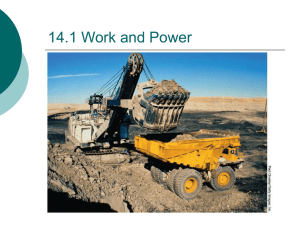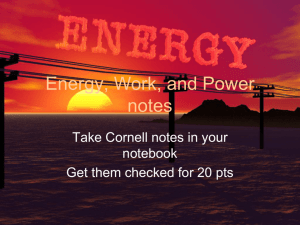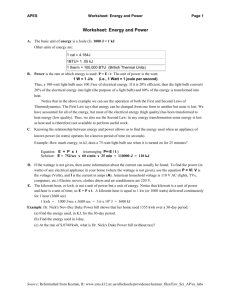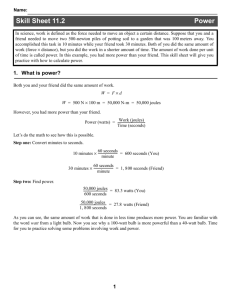Unit 4-What is work
advertisement
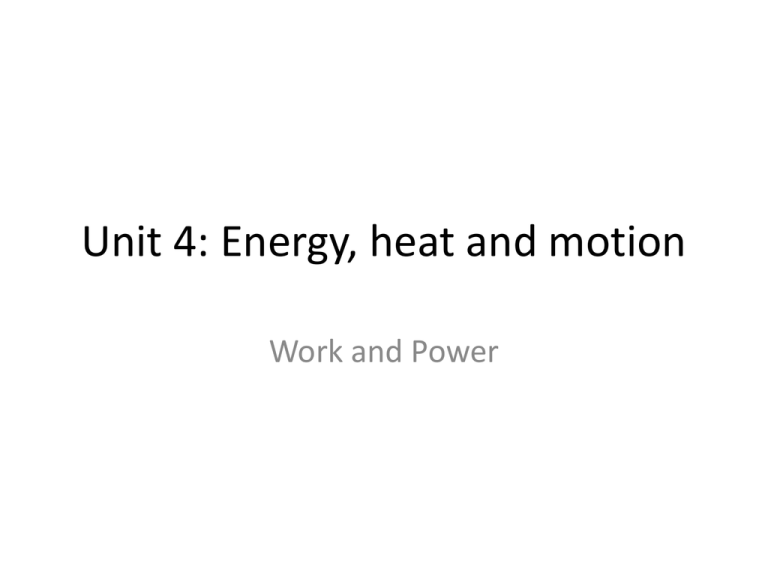
Unit 4: Energy, heat and motion Work and Power What is work? • Definition: work occurs when a force causes an object to move in the direction of the force. • characteristic – the direction the object moves MUST be in the same direction of FORCE to be considered WORK • Ex. • Force • Distance it moves Work or not work? Example Josh pushing a box across the floor. Symone carrying her books to her next class Ms. Tran lifting a box off the ground De’Andre placing a box on the ground Direction of force Direction of movement Doing work? (yes/no) How do we calculate work? • Formula: work = force x distance • Ex. Find the work done on the box if a force of 55N was applied to the right and the box moved a distance of 10m. • 55N • 10M • Is work being done on this object? Work out the problem • Work = force x distance • Work = 55N x 10m • Work = 550 Newton-meters or JOULES (J) Practice Problem #1 • Marquise applies a force of 500N to push a truck 100m down the street. How much work does he do? Practice Problem #2 • In which situation do you do more work? (Calculate the work done in each scenario) – A. you lift a 75N bowling ball 2m off the floor. – B. You lift two 50N bowling balls 2m off the floor. Energy • DEFINITION: Energy is the ability to do work. • Energy is all around you! You can hear energy as sound. You can see energy as light. You can feel energy as wind. You use energy to bounce a basketball or lift a backpack. Energy & Work • What do energy and work have to do with each other? • Energy and Work are directly related…in fact, they are both measured in JOULES! • Objects can gain energy because work is being done on them. Can you think of any examples? Energy & Work: Examples • When you kick a football, you give some of your energy to the football to make it move. • When you throw a bowling ball, you give it energy to make it roll. • When the bowling ball hits the pits, it loses some of its energy to the pins, causing them to fall! Power • What is power? Power • DEFINITION: Power is the rate at which work is done. • FORMULA: Power = Work ÷ Time • Or: Power = Energy ÷ Time • Or: (Force x Distance) ÷ Time • Unit of measure: Watt (W) Power: Let’s Practice… • An Antarctic explorer uses 6000 Joules of work to pull his sled for 60 seconds. What power does he need? • Power = Work ÷ Time • Work = 6000J, Time = 60sec • Power = 6000J ÷ 60sec = 100 Watts Power: Let’s Practice… • If a conveyor belt at a candy factory uses 10 J to move a piece of candy a distance of 3 meters in 20 seconds, what is the conveyor belt’s power? • Power = Work ÷ Time • Work = 10 J, Time = 20 sec • Power = 10 J ÷ 20 sec = 0.5 Watts Light Bulbs • But wait! Aren’t watts used to describe light bulbs??? • Yes! For example, a 60-watt light bulb uses 60 joules of energy every second to shine! Power: Let’s Practice… • A light bulb uses 600 J of energy in 6 seconds. What is the power of the light bulb? • Power = Energy ÷ Time • Energy = 600 J, Time = 6 sec • Power = 600 J ÷ 6 sec = 100 watts More Practice… • What two factors do you need to know in order to calculate how much work was done in any situation? • Answer: You need to know FORCE and DISTANCE. More Practice… • If you push very hard on an object but it does not move, have you done work? Why or why not? • Answer: NO! The object must move for work to be done. More Practice… • Was work done on a book that fell from a desk to the floor? If so, which force was involved? • Answer: YES! The force of GRAVITY was involved. More Practice… • Work is done on a ball when a soccer player kicks it. Is the player still doing work on the ball as it rolls across the ground? Why or why not? • NO! The player is no longer doing work on the ball while it is rolling. The ball keeps rolling because of inertia. More Practice… • How is Power related to Work? • Answer: Power is the rate at which work is done. The faster you do work, the greater your power. More Practice… • By increasing the SPEED at which you work, you can increase your: a) Force b) Work c) Energy d) Power Answer: d) Power More Practice… • Which takes more power: using 15 Newtons to lift a ball 2 meters for 5 seconds, or using 100 Newtons to push a box 2 meters in 50 seconds? • Answer: The first situation. • Power = (15N x 2m) ÷ 5 sec = 6 W • Power = (100N x 2m) ÷ 50 sec = 4W – 6 Watts is greater than 4 Watts More Practice… • How can you tell if a force you apply to an object is doing work? • Answer: You can tell the force is doing work because the object will MOVE. More Practice… • How much work is done if you drag a box weighing 150 Newtons a distance of 30 meters? • Work = Force x Distance • Force needed to drag suitcase = 150N • Distance = 30m • Work = 150N x 30m = 4,500 Joules (J) More Practice… • A light bulb uses 400 J of energy in 8 seconds. What is the power of the light bulb? • Power = Energy ÷ Time • Energy = 400 J, Time = 8 sec • Power = 400 J ÷ 8 sec = 50 watts Exit Ticket: So What Did We Learn? • • • • What is WORK? What is ENERGY? What is POWER? How do they all relate to what we’ve already learned about FORCE?
